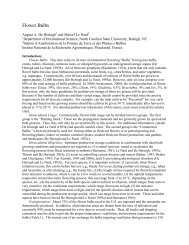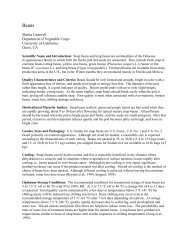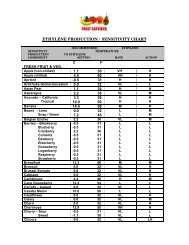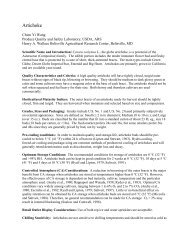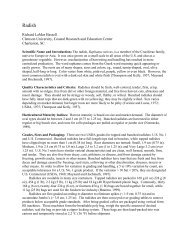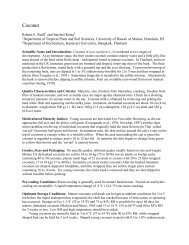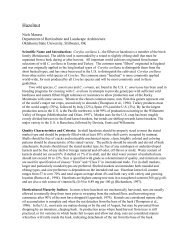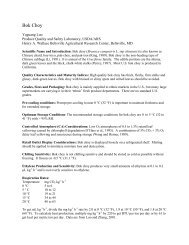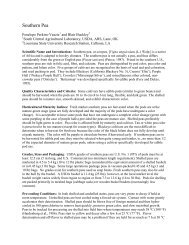Peanut
Peanut
Peanut
Create successful ePaper yourself
Turn your PDF publications into a flip-book with our unique Google optimized e-Paper software.
<strong>Peanut</strong><br />
Niels Maness<br />
Department of Horticulture and Landscape Architecture<br />
Oklahoma State University, Stillwater, OK<br />
Scientific Name and Introduction: Arachis hypogaea L., the peanut or groundnut, is an annual herb of<br />
the Leguminosae family. Two subspecies are grown commercially, and four market types are of greatest<br />
economic importance. A. hypogaea subsp. hypogaea includes the market types runner and virginia, and A.<br />
hypogaea subsp. fastigata includes the market types spanish and valencia. In the U.S., in the 1980's, 70%<br />
of the peanuts grown were runners, while 20, 10 and < 1% were virginia, spanish and valencia market<br />
types, respectively (Knauft and Gorbet, 1989). According to the USDA national peanut tonnage report,<br />
U.S. production in 1999 included 78% runners, 18% virginia, 3% spanish and 3% valencia. The edible<br />
portion is a seed which develops underground inside a pod containing two to four seeds. <strong>Peanut</strong>s<br />
originated in South America and are now cultivated world wide with the majority of production in India,<br />
Asia and the U.S. In the U.S., about 60% of peanuts are utilized in a variety of food products, with the<br />
reminder used in approximately equal proportions for export and for production of edible oil. Major<br />
chemical constituents of peanuts are oil (44 to 56%) and protein (22 to 33%), with a large influence of<br />
environment, genotype and maturity on their concentrations (Holaday and Pearson, 1974).<br />
Quality Characteristics and Criteria: Shelled peanuts should be properly sized to meet market type, be<br />
free of misshapen or under-developed kernels and be free of any shell or foreign material and off-odor or<br />
flavor. Raw peanuts should be surrounded by a tan, pink or red- colored seed coat (testa) that fully<br />
encapsulates the seed, and the interior color of each half-seed should be ivory. Moisture content for inshell<br />
peanuts should be < 10% to prevent mold growth (Diener and Davis, 1977). Prior to shelling,<br />
peanuts should contain 7 to 10% moisture to reduce splitting and kernel breakage during milling. After<br />
milling, moisture content for maximum shelf-life is ≤ 7%. Seed may be stored at ambient temperature for<br />
up to 11 years with good viability if seed moisture content is < 3.3% (Cheng et al., 1997). <strong>Peanut</strong>s<br />
marketed without seed coats (blanched) should have an ivory colored raw kernel. <strong>Peanut</strong>s are most<br />
commonly consumed following roasting that may be accomplished in-shell or after shelling. Roasted<br />
peanut kernels should be light-yellow in color, free of external oil, contain < 6% moisture and be free of<br />
dark-colored kernels. <strong>Peanut</strong> seed, and particularly peanut seed coats, are a source of resveratrol, a<br />
compound that reduces cardiovascular disease and cancer incidence. Resveratrol ranges from 0.02 to 1.79<br />
µg/g, compared to 0.6 to 8.0 µg/ml in red wines (Sanders et al., 2000). Fatty acid composition of peanut<br />
oil is predominantly oleic and linoleic acid, found in roughly equal amounts, and making up 80% of total<br />
fatty acids. Certain genotypes may contain substantially more oleic than linoleic acid, with ratios as high<br />
as 40:1 (oleic:linoleic). <strong>Peanut</strong>s with a high oleic:linoleic acid ratio are less susceptible to oxidative<br />
deterioration and off-flavor development caused by oxidative cleavage of polyunsaturated fatty acids. The<br />
ratio of oleic to linoleic is influenced primarily by genotype, but interactions exist between genotype and<br />
the environment.<br />
Horticultural Maturity Indices:. <strong>Peanut</strong>s are an indeterminant plant, with flowering followed by<br />
underground seed development occurring over a range of time. Assessment of peanut maturity should be<br />
conducted using multiple plants at various locations within a field. <strong>Peanut</strong> maturity may be judged by the<br />
shell-out procedure, involving separation of peanut seed into mature or immature categories. Using the<br />
shell-out procedure, a peanut is considered mature if the inner hull is brown and the seed coat is pink to<br />
red. Optimum maturity is reached for runner and spanish types when 75 to 80% of the inner hull has<br />
turned brown, and for virginia types when 65% of the seed coat has turned deep pink in color. Runner<br />
peanut maturity can be determined by a hull-scrape method, in which maturity profiles for samples are
estimated based on degree of change in pod mesocarp from white to brown to black (Williams and<br />
Drexler, 1981).<br />
Grades, Sizes and Packaging: U.S. grade standards and industry grade standards from the American<br />
<strong>Peanut</strong> Shellers Association (ASPA) exist for shelled spanish, shelled runner, shelled virginia and in-shell<br />
virginia peanuts. A comparison of tolerances as provided by the American <strong>Peanut</strong> Shellers Association<br />
Official Trade Rules for shelled peanuts based primarily on size, peanuts of other types, amount of split or<br />
broken kernels, freedom from foreign material, damage, minor defects and in some cases moisture percent<br />
is presented in Tables 1 to 4. Tolerances for in-shell virginia peanuts based on maturity, freedom from<br />
loose shelled peanuts, discoloration of shell, dirt, shell and other foreign material and degree of kernel fill<br />
inside the shell are compared.<br />
Table 1. Comparison of screen sizes and tolerances (by weight) for American <strong>Peanut</strong> Shellers Association<br />
and USDA Grades for shelled spanish peanuts.<br />
Grade & Minimum<br />
Screen Size<br />
% Fall-Thru<br />
Prescribed<br />
Screens<br />
%<br />
Other<br />
Types<br />
%<br />
Splits<br />
%<br />
Damage<br />
%<br />
Damage<br />
and Minor<br />
Defects<br />
% Foreign<br />
Material<br />
% Moisture<br />
NO. 1 (15/64 x 3/4"<br />
Slot)<br />
APSA<br />
US<br />
2.00<br />
2.00<br />
1.00<br />
1.00<br />
3.00<br />
3.00<br />
0.75<br />
1.50<br />
1.25<br />
2.00<br />
0.10<br />
0.10<br />
9.00<br />
-----<br />
SPLITS (16/64"<br />
Round)<br />
APSA<br />
US<br />
*<br />
**<br />
2.00<br />
2.00<br />
----<br />
----<br />
1.50<br />
2.00<br />
2.00<br />
2.00<br />
0.20<br />
0.20<br />
9.00<br />
----<br />
* (APSA) - 2.00% sound portions of peanuts which pass through the prescribed screen; and 4.00% for sound whole kernels,<br />
not over 3.00% which will pass through a 13/64 x 3/4" screen. This fall-through combined with % of sound portions shall<br />
not exceed 4.00%.<br />
** (US) - 2.00% sound portions of peanuts which will pass through the prescribed screen; and 4.00% for sound whole<br />
kernels.<br />
NO. 2 (16/64" Round)<br />
APSA<br />
US 6.00***<br />
6.00***<br />
2.00<br />
2.00<br />
----<br />
----<br />
1.00<br />
----<br />
2.00<br />
2.50<br />
0.20<br />
0.20<br />
9.00<br />
----<br />
*** Combined fall-through of sound portions through a 16/64" round screen and sound whole kernels through a 13/64 x 3/4"<br />
screen shall not exceed 4.00%
Table 2. Comparison of screen sizes and tolerances (by weight) for American <strong>Peanut</strong> Shellers Association<br />
and USDA Grades for shelled runner peanuts.<br />
Grade & Minimum<br />
Screen Size<br />
% Fall-<br />
Thru<br />
Prescribed<br />
Screens<br />
% Fall-<br />
Thru<br />
16/64 x 3/4"<br />
Slot Screen<br />
%<br />
Other<br />
Types<br />
%<br />
Splits<br />
%<br />
Damage<br />
%<br />
Damage<br />
&<br />
Minor<br />
Defects<br />
%<br />
Foreign<br />
Material<br />
%<br />
Moisture<br />
JUMBO<br />
38-42 CT. per OZ.***<br />
or 21/64 x 3/4" Slot<br />
MEDIUM<br />
40-50 CT. per OZ.*** or<br />
18/64 x 3/4" Slot<br />
(Report % Riding 21/64 x<br />
3/4" Slot)<br />
SELECT<br />
16/64 x 3/4" Slot<br />
(Report % Riding 21/64 x<br />
3/4" Slot)<br />
5.00 3.00 1.00 3.00 1.00 2.00 0.10 9.00<br />
5.00 3.00 1.00 3.00 1.00 2.00 0.10 9.00<br />
---- 3.00 1.00 3.00 1.00 2.00 0.10 9.00<br />
NO. 1<br />
16/64 x 3/4" Slot<br />
(Report % Riding 18/64 x<br />
3/4" Slot)<br />
APSA<br />
US<br />
----<br />
----<br />
3.00<br />
3.00<br />
1.00<br />
1.00<br />
3.00<br />
3.00<br />
1.00<br />
1.50<br />
2.00<br />
2.00<br />
0.10<br />
0.10<br />
9.00<br />
----<br />
MILL RUN<br />
16/64 x 3/4" Slot<br />
---- 3.00 1.00 3.00 1.00 2.00 0.10 9.00<br />
SPLITS<br />
17/64" Round<br />
APSA<br />
US<br />
*<br />
**<br />
*<br />
**<br />
2.00<br />
2.00<br />
----<br />
----<br />
1.50<br />
2.00<br />
2.00<br />
2.00<br />
0.20<br />
0.20<br />
9.00<br />
----<br />
* (APSA) - 2.00% sound portions pass through 17/64" round. 4.00% for sound whole kernels, not over 3.00% which will pass<br />
through 14/64 x 3/4" slot screen. This fall-through combined with sound portions passing 17/64" round not to exceed 4.00%.<br />
** (US) - 2.00% sound portions pass through 17/64" round. 4.00% for sound whole kernels.<br />
*** American count per ounce shall be within the specified range.<br />
“With Splits” - Each of the above grades may be certified “with splits” providing all requirements of the grade are met;<br />
Except a tolerance of 15% is allowed for split kernels of which not more than 3% will pass through 17/64" round screen.
Table 3. Comparison of screen sizes and tolerances (by weight) for American <strong>Peanut</strong> Shellers Association<br />
and USDA Grades for shelled Virginia peanuts<br />
Grade & Minimum<br />
Screen Size<br />
% Fall-<br />
Thru<br />
Prescribed<br />
Screens<br />
%<br />
Other<br />
Types<br />
%<br />
Sound<br />
Split or<br />
Broken<br />
Kernel<br />
s<br />
%<br />
Damage<br />
%<br />
Damage<br />
& Minor<br />
Defects<br />
%<br />
Foreign<br />
Material<br />
%<br />
Moisture<br />
Count Per<br />
Pound<br />
Maximum<br />
EXTRA LARGE<br />
20/64 x 1" Slot<br />
APSA - US<br />
MEDIUM VIRGINIA<br />
18/64 x 1" Slot<br />
APSA - US<br />
NO. 1 VIRGINIA<br />
15/64 x 1" Slot<br />
APSA - US<br />
3.00 0.75 3.00 1.00 1.75 0.10 ---- **512<br />
3.00 1.00 3.00 1.25 2.00 0.10 ---- **640<br />
3.00 1.00 3.00 1.25 2.00 0.10 ---- **864<br />
VIRGINIA SPLITS<br />
20/64" Round<br />
APSA - US<br />
*3.00 2.00<br />
Not<br />
Less<br />
Than<br />
90.00<br />
---- 2.00 0.20 ---- ----<br />
NO. 2 VIRGINIA<br />
17/64" Round<br />
APSA - US<br />
*6.00 2.00<br />
As<br />
Graded<br />
---- 2.50 0.20 ---- ----<br />
* (APSA-US) - Includes both sound split and broken and sound whole kernels which pass through prescribed screens.<br />
“With Splits” - Each of the above APSA whole grades may be certified as “with splits” providing all requirements of the grade<br />
are met: except a tolerance of 15% is allowed for split kernels of which not more than 3% will pass through 17/64" round screen.<br />
** U.O.S. - Unless Otherwise Specified<br />
Table 4. Comparison of screen sizes and tolerances (by weight) for American <strong>Peanut</strong> Shellers Association<br />
and USDA Grades for in-shell Virginia peanuts.<br />
Grade<br />
& Minimum Screen<br />
Size<br />
% Fall-Thru<br />
Prescribed<br />
Screen<br />
% Cracked or Broken<br />
Shells, Pops, Paper &<br />
Foreign Material<br />
% Damaged<br />
Kernels<br />
Count Per Pound<br />
JUMBO<br />
37/64 x 3"<br />
APSA<br />
US<br />
5.00<br />
5.00<br />
*10.00<br />
*10.00<br />
3.50<br />
3.50<br />
**176 (U.O.S.)<br />
**176 (U.O.S.)<br />
FANCY<br />
32/64 x 3"<br />
APSA<br />
US<br />
5.00<br />
5.00<br />
*11.00<br />
*11.00<br />
4.50<br />
4.50<br />
**225 (U.O.S.)<br />
**225 (U.O.S.)<br />
* (APSA-US) - Not more than .5% shall be allowed as dirt or other foreign material.<br />
** U.O.S. - Unless Otherwise Specified.
Raw in-shell peanuts are typically stored as “farmer stock peanuts” in flat, ventilated warehouses or<br />
grain bins in bulk or, less commonly in 50 lb burlap bags, for a week to 10 mo prior to shelling (Smith,<br />
Blankenship and McIntosh, 1995). After shelling, raw peanuts are often shipped in bulk containers, but<br />
may be packaged in burlap or nylon tote bags of various sizes. <strong>Peanut</strong>s for human consumption must be<br />
free of visible Aspergillus flavus mold, contain less than 15 ppb aflatoxin. Lots imported into the U.S.<br />
may be designated “segregation 1” or “segregation 2” depending on degree of kernel damage and<br />
concealed damage from rancidity, mold or decay. Segregation 1 peanuts may not contain more than<br />
2.00% damaged kernels nor more than 1.00% concealed damage while segregation 2 peanuts may contain<br />
more than 2.00% damaged or more than 1.00% concealed damage. Segregation 3 peanuts are those which<br />
contain visible Aspergillus flavus mold or 15 ppb or more aflatoxin.<br />
Optimum Storage Conditions: In-shell farmers stock peanuts dried to about 7.5% moisture. If stored at<br />
10 °C (50 °F), these can be stored for up to 10 mo without significant quality loss (Davidson et al., 1982).<br />
High losses in milling quality may occur if peanuts are dried to below 7% moisture or if kernel<br />
temperature is below 7 °C (44.6 ºF) during shelling (McIntosh and Davidson, 1971). <strong>Peanut</strong> moisture<br />
contents > 10% should be avoided to prevent mold growth (Diener and Davis, 1977). Adequate<br />
ventilation in a warehouse storage facility, preferably providing one air change every 3 min, is also<br />
desirable to prevent excess moisture and heat from accumulating in the storage facility (Smith and<br />
Davidson, 1982). Quality of raw shelled peanuts can be maintained for at least 1 year at 1 to 5 °C (33.8 to<br />
41 °F) with moisture contents < 7%, or for 2 to 10 years at -18 °C (0 °F) and < 6 % moisture. Maintaining<br />
RH between 55 and 70% at 1 to 5 °C (33.8 to 41 °C) will maintain peanut moisture content at 7 to 7.5%.<br />
Careful handling of peanuts equilibrated to < 5 °C (41 °F) is necessary to prevent bruising and subsequent<br />
oil seepage from damaged cells within the cotyledon. Upon removal of raw shelled peanuts from<br />
refrigerated or frozen storage, equilibration to ambient temperature should be gradual in conditioning<br />
rooms, with RH/temperature/air-flow adjusted to prevent moisture condensation onto peanuts.<br />
Controlled Atmosphere Considerations: Low O 2 storage shows promise for delaying rancid flavor<br />
development and insect infestation (Slay et al., 1985). High CO 2 storage appears to limit growth of<br />
Aspergillus flavus in short duration storage of high moisture, non-cured peanuts. <strong>Peanut</strong>s at 20% moisture<br />
stored at 0.6 to 3 °C (33 to 37.4 °F) in a high CO 2 environment had acceptable quality for 4 days, but<br />
deteriorated after 8 days of storage (Moseley et al., 1971). For longer term storage of high moisture,<br />
shelled peanuts under ambient temperature conditions, O 2 < 1.5% were required to slow Aspergillus<br />
flavus growth, but no CA totally eliminated aflatoxin production (Wilson and Jay, 1976).<br />
Retail Outlet Display Considerations: <strong>Peanut</strong>s are normally marketed at ambient temperature<br />
conditions. Use of low O 2 and preventing excessive exposure to light is recommended. In-shell peanuts<br />
may be displayed and marketed in bulk containers. Exposure to moisture or high RH should be avoided.<br />
Chilling Sensitivity: Prior to or during harvest, and prior to postharvest drying, exposure to chilling<br />
temperatures of 0.9 to 1.6 °C (33.6 to 34.9 °F) caused increased ethanol production, and the effect was<br />
greater for small as compared to large seed within a genotype. This was accompanied by increased seed<br />
leachate, suggested by the authors to be indicative of induction of anaerobic respiration and cell<br />
membrane damage (Singleton and Pattee, 1989). Following postharvest drying and during storage peanuts<br />
do not appear to be sensitive to chilling temperatures and may be stored at or below freezing.<br />
Ethylene Production and Sensitivity: <strong>Peanut</strong> seeds exhibit dormancy periods following harvest of 63 to<br />
84 days, varying with genotype and temperature during pod maturation and storage. Soaking seeds in 50<br />
to 200 µg GA 3 or ethephon per mL of solution was effective in breaking dormancy (Kapur et al., 1990).<br />
Non-dormant peanuts exhibit a climacteric-like rise in ethylene production during seed germination<br />
(Whitehead and Nelson, 1992).
Respiration Rates: Properly cured peanuts in storage exhibit a relatively low rate of respiration. During<br />
harvest and prior to curing, especially for high moisture peanuts, respiration rates may be substantial and<br />
significant losses in quality can ensue. Freshly harvested peanuts should be dried soon after harvest to <<br />
10% moisture to assure optimum quality.<br />
Physiological Disorders: Shriveled seed trait has been identified as a heritable condition for peanuts.<br />
Seed mature normally but appear shriveled, and thus appear to have been harvested while immature.<br />
Seeds of shriveled lines exhibit up to 67% less oil, double the amount of sucrose, and defatted meal<br />
contained less protein (Jakkula et al., 1997). Improper curing of peanuts results in loss of quality and offflavor<br />
development. Freezing temperatures occurring during harvest while peanuts are still windrowed<br />
(Singleton and Pattee, 1991), or curing at too high a temperature (Sanders et al., 1989) resulted in<br />
fermented, fruity off-flavor. Effects of improper curing are greatest on smaller seed, perhaps indicating<br />
greater effect on immature seed (Sanders et al., 1990).<br />
Postharvest Pathology: <strong>Peanut</strong>s are susceptible to infection by various molds and fungi, and a<br />
combination of storage at 1 to 5 °C (33.8 to 41 °F) and reduction of moisture content < 7.5% may be<br />
effective in reducing mold and fungi growth in storage. The presence of toxic fungal metabolites<br />
(mycotoxins) are a particular concern. The name aflatoxin refers to four metabolites found in<br />
contaminated peanuts and designated aflatoxin B 1, B 2 , G 1 and G 2 . Aflatoxins B 1 and B 2 are metabolites of<br />
Aspergillus flavus and all four aflatoxins may be produced by Aspergillus parasiticus (Cole et al., 1995).<br />
A fifth mycotoxin which is somewhat less toxic than aflatoxin and is produced by Aspergillus flavus,<br />
other Aspergillus species, and several species of Penicillium, is cyclopiazonic acid (Dorner et al., 1985).<br />
Pre-harvest conditions favoring aflatoxin contamination are high temperatures and drought stress during<br />
the last 3 to 6 weeks of the growing season (Cole et al., 1989). Late season irrigation may be effective in<br />
reducing aflatoxin contamination (Dorner et al., 1989). When aflatoxin contamination occurs, it is<br />
common for most of the harvested seed to be free of contamination with only a few highly contaminated<br />
seed. Although monitoring at the point of sale for Aspergillus flavus is mandated by the USDA <strong>Peanut</strong><br />
Marketing Agreement, and detection of 15 ppb aflatoxin or more leads to positive aflatoxin identification,<br />
the irregular distribution of infection may lead to false negative designations. Storage conditions to deter<br />
growth of the causal organisms and subsequent metabolic production of the mycotoxins primarily involve<br />
prevention of rehydration during storage. Decontamination of contaminated lots is most effectively done<br />
with electronic color sorting, although size and density separation may also be effective in removal of the<br />
most susceptible underdeveloped seed.<br />
Quarantine Issues: Importation of peanut seed into the U.S. for planting is prohibited from Burkino,<br />
Faso, the People’s Republic of China, Cote de’Ivoire, India, Indonesia, Ivory Coast, Japan, the<br />
Phillipines, Senegal, Thailand and Taiwan because of peanut stripe virus. During import of peanuts, all<br />
lots must be labeled with a positive lot identification and must meet the requirements for segregation 1<br />
peanuts if used for human consumption. <strong>Peanut</strong>s with visible Aspergillus flavus mold, or those containing<br />
≥ 15 ppb aflatoxin, may not be used for edible purposes; they may be used for oil stock. Such peanuts<br />
may be blanched and re-separated into aflatoxin-negative lots which may be used for edible purposes.<br />
Special Considerations: <strong>Peanut</strong>s are a major allergenic food among adults and children in the U.S.<br />
(Taylor, 1992). Allergen activity has been identified for at least six allergens by phage display<br />
technology, and are known to be in association with the two major storage proteins, arachin and<br />
conarachin, and in profilin (Kleber et al., 1999). Allergens may also be present in refined peanut oil<br />
(Olszewski et al., 1998). Due in large part to allergenicity, any food product containing peanuts or peanut<br />
oil must be labeled as such. Careful handling of cured farmers stock peanuts to prevent breakage of shells<br />
reduces the risk for spread of fungal contamination and maintains the grade. Conveyors, cleaners, sizers
and other handling equipment should be padded where appropriate and properly maintained to prevent<br />
excessive breakage during handling. Once shelled and roasted, peanuts should be handled carefully to<br />
prevent separation of the half kernels and breakage since splits and pieces are more susceptible to<br />
oxidative deterioration and rancidity development. <strong>Peanut</strong>s will absorb lipophilic volatiles from their<br />
surroundings, or from inappropriate packaging that can induce off-flavors. Absorption of ammonia can<br />
cause darkening of nutmeats.<br />
References:<br />
Cheng, H.Y., G.H. Zheng, X.M. Jing, T.Y. Kuang, P.S. Tang, K.L. Tao, M.D. Zhou and N.X. Duan.<br />
1997. Storage of peanut seeds with low moisture content for 11 years in ambient temperature. Plant<br />
Gen. Resour. Newsletter 110:35-40.<br />
Cole, R.J., T.H. Sanders, J.W. Dorner and P.D. Blankenship. 1989. Environmental conditions required to<br />
induce preharvest aflatoxin contamination of groundnuts: Summary of six years research. In:<br />
Aflatoxin contamination of groundnut. Proc. Intl. Wkshp, ICRISAT Cntr, Patancheru, Peru, pp. 279-<br />
287.<br />
Cole, R.J., J.W. Dorner and C.C. Holbrook. 1995. Advances in mycotoxin elimination and resistance. In:<br />
H.E. Pattee and H.T. Stalker (eds) Adv. <strong>Peanut</strong> Sci., Amer. <strong>Peanut</strong> Res. Ed. Soc., Stillwater OK, pp.<br />
456-474.<br />
Davidson, J.I., T.B. Whitaker and J.W. Dickens. 1982. Grading, cleaning, storage, shelling and marketing<br />
of peanuts in the United States. In: H.E. Pattee and C.T. Young (eds) <strong>Peanut</strong> Sci. Technol., Amer.<br />
<strong>Peanut</strong> Res. Ed. Soc., Yoakum TX, pp. 571-623.<br />
Diener, U.L. and N.D. Davis. 1977. Aflatoxin formation in peanuts by Aspergillus flavus. Auburn Univ.<br />
Agric. Exp. Stn. Bull. 493.<br />
Dorner, J.W., R.J. Cole and L.G. Lomax. 1985. The toxicity of cyclopiazonic acid. In: J. Lacey (ed)<br />
Trichothecenes and Other Mycotoxins, John Wiley and Sons, NY, pp. 529-535.<br />
Dorner, J.W., R.J. Cole, T.H. Sanders and P.D. Blankenship. 1989. Interrelationship of kernel water<br />
activity, soil temperature, maturity and phytoalexin production in pre-harvest aflatoxin accumulation<br />
of drought-stressed peanuts. Mycopathalogia 105:117-128.<br />
Holaday, C.E. and J.L. Pearson. 1974. Effects of genotype and production area on the fatty acid<br />
composition, total oil and total protein in peanuts. J. Food Sci. 39:1206-1209.<br />
Jakkula, L.R., S.F. O’Keefe, D.A. Knauft and K.J. Boote. 1997. Chemical characterization of a shriveled<br />
seed trait in peanut. Crop Sci. 37:1560-1567.<br />
Kapur, A., J. Kaur, H.L. Sharma and H. Singh. 1990. Preconditioning of peanut (Arachis hypogaea) seeds<br />
to release dormancy. Ann. Biol. Ludhiana 6:141-145.<br />
Kleber, J.T., R. Crameri, U. Appenzeller, M. Cshlaak and W.M. Becker. 1999. Selective cloning of<br />
peanut allergens, including profilin and 2S albumins, by phage display technology. Int. Arch.<br />
Allergy Immun. 119:265-274.<br />
Knauft, D.A. and D.W. Gorbet. 1989. Genetic diversity among peanut cultivars. Crop Sci. 29:1417-1422.<br />
McIntosh, F.P. and J.I. Davidson. 1971. Effect of temperature on shelling runner- and spanish-type<br />
peanuts. USDA, ARS 52-65, U.S. Govt. Print. Office, Washington DC.<br />
Moseley, Y.C., H.B. Manbeck, G.L. Barnes and G.L. Nelson. 1971. Controlled atmosphere for short<br />
duration storage of peanuts before drying. Trans. Amer. Soc. Agr. Eng. 14:206-210.<br />
Olszewski, A., L. Pons, F. Moutete, G.I. Aimone, G. Kanny, D.A. Moneret-Vautrin and J.L. Gueant.<br />
1998. Isolation and characterization of proteic allergens in refined peanut oil. Clin. Exper. Allergy<br />
28:850-859.<br />
Sanders, T.H., J.R. Verecellotti, P.B. Blankenship, K.L. Crippen and G.V. Civille. 1989. Interaction of<br />
maturity and curing temperature on descriptive flavor of peanuts. J. Food Sci. 54:1066-1069.<br />
Sanders, T.H., P.B. Blankenship, J.R. Vercellotti and K.L. Crippen. 1990. Interaction of curing<br />
temperature and inherent maturity distribution in descriptive flavor of commercial grade sizes of<br />
Florunner peanuts. <strong>Peanut</strong> Sci. 17:85-89.
Sanders, T.H., R.W. McMichael and K.W. Hendrix. 2000. Occurrence of resveratrol in edible peanuts. J.<br />
Agric. Food Chem. 48:1243-1246.<br />
Singleton, J.A. and H.E. Pattee. 1989. Effect of chilling injury on windrowed peanuts. <strong>Peanut</strong> Sci. 16:51-<br />
54.<br />
Singleton, J.A. and H.E. Pattee. 1991. <strong>Peanut</strong> moisture/size, relation to freeze damage and effect of drying<br />
temperature on volatiles. J Food Sci. 56:579-581.<br />
Slay, W.O., W.G. Ferguson and J.A. Pomplin. 1985. Some effects of conventional and low-oxygen<br />
atmosphere storage and processing methods on Florunner peanut seed. <strong>Peanut</strong> Sci. 12:8-11.<br />
Smith, J.S., P.D. Blankenship and F.P. McIntosh. 1995. Advances in peanut handling, shelling and<br />
storage from farmer stock to processing. In: H.E. Pattee and H.T. Stalker (eds) Adv. <strong>Peanut</strong> Sci.,<br />
Amer. <strong>Peanut</strong> Res. Edu. Soc., Stillwater OK, pp. 500-527.<br />
Smith, J.S. and J.I. Davidson. 1982. Psychometrics and kernel moisture content as related to peanut<br />
storage. Trans. Amer. Soc. Agric. Eng. 25:231-236.<br />
Taylor, S.L. 1992. Chemistry and determination of food allergens. Food Tech. 46:146-152.<br />
Whitehead, C.S. and R.M. Nelson. 1992. Ethylene sensitivity in germinating peanut seeds: The effect of<br />
short-chain fatty acids. J. Plant Physiol. 139:479-483.<br />
Williams, E.J. and J.S. Drexler. 1981. A non-destructive method for determining peanut pod maturity.<br />
<strong>Peanut</strong> Sci. 8:134-141.<br />
Wilson, D.A. and E. Jay. 1976. Effect of controlled atmosphere storage on aflatoxin production in high<br />
moisture peanuts (groundnuts). J. Stored Prod. Res. 12:97-100.



